Understanding Legal Implications in Employment Discrimination Cases
VerifiedAdded on 2020/05/28
|8
|1565
|191
AI Summary
The assignment examines two cases within the scope of employment law. The first case addresses issues of discrimination under Title VII and explores concepts like disparate treatment and disparate impact using relevant legal precedents such as Griggs v Duke Power Co. It analyzes potential liabilities for employers in discriminatory practices. The second case focuses on vicarious liability, examining how an employer can be held accountable for the actions of its employees under doctrines such as respondeat superior. This includes a discussion on tort law implications and managerial strategies to mitigate such risks.
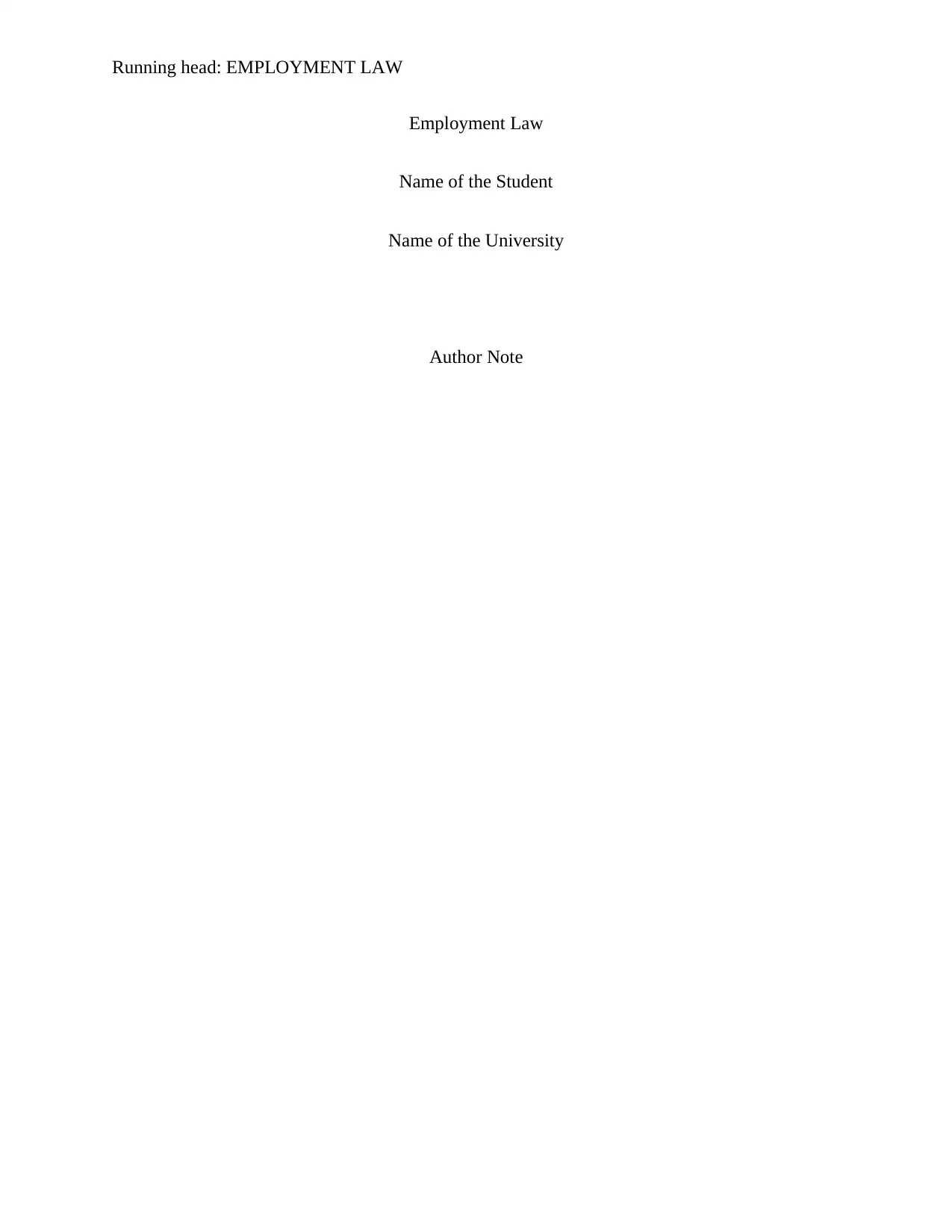
Running head: EMPLOYMENT LAW
Employment Law
Name of the Student
Name of the University
Author Note
Employment Law
Name of the Student
Name of the University
Author Note
Paraphrase This Document
Need a fresh take? Get an instant paraphrase of this document with our AI Paraphraser
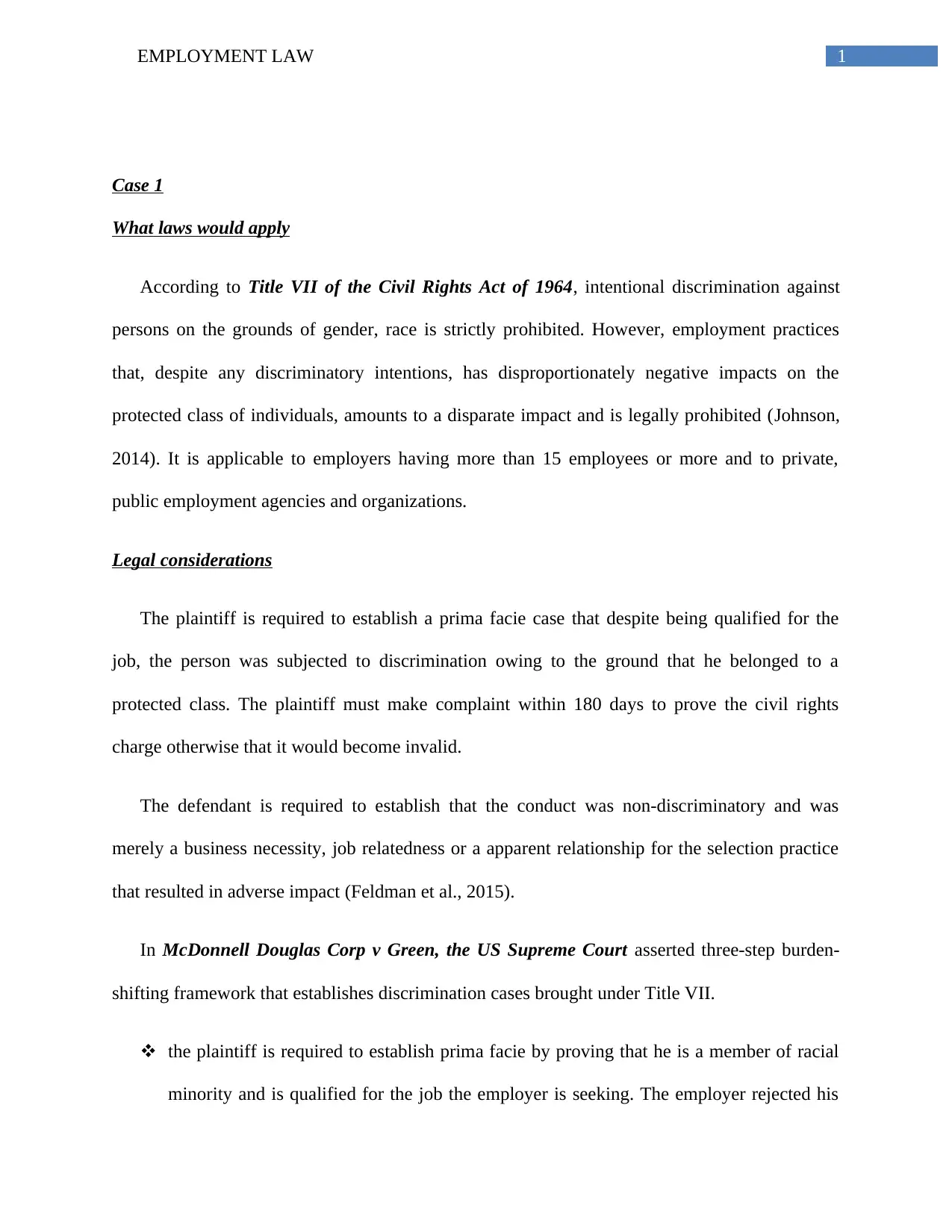
1EMPLOYMENT LAW
Case 1
What laws would apply
According to Title VII of the Civil Rights Act of 1964, intentional discrimination against
persons on the grounds of gender, race is strictly prohibited. However, employment practices
that, despite any discriminatory intentions, has disproportionately negative impacts on the
protected class of individuals, amounts to a disparate impact and is legally prohibited (Johnson,
2014). It is applicable to employers having more than 15 employees or more and to private,
public employment agencies and organizations.
Legal considerations
The plaintiff is required to establish a prima facie case that despite being qualified for the
job, the person was subjected to discrimination owing to the ground that he belonged to a
protected class. The plaintiff must make complaint within 180 days to prove the civil rights
charge otherwise that it would become invalid.
The defendant is required to establish that the conduct was non-discriminatory and was
merely a business necessity, job relatedness or a apparent relationship for the selection practice
that resulted in adverse impact (Feldman et al., 2015).
In McDonnell Douglas Corp v Green, the US Supreme Court asserted three-step burden-
shifting framework that establishes discrimination cases brought under Title VII.
the plaintiff is required to establish prima facie by proving that he is a member of racial
minority and is qualified for the job the employer is seeking. The employer rejected his
Case 1
What laws would apply
According to Title VII of the Civil Rights Act of 1964, intentional discrimination against
persons on the grounds of gender, race is strictly prohibited. However, employment practices
that, despite any discriminatory intentions, has disproportionately negative impacts on the
protected class of individuals, amounts to a disparate impact and is legally prohibited (Johnson,
2014). It is applicable to employers having more than 15 employees or more and to private,
public employment agencies and organizations.
Legal considerations
The plaintiff is required to establish a prima facie case that despite being qualified for the
job, the person was subjected to discrimination owing to the ground that he belonged to a
protected class. The plaintiff must make complaint within 180 days to prove the civil rights
charge otherwise that it would become invalid.
The defendant is required to establish that the conduct was non-discriminatory and was
merely a business necessity, job relatedness or a apparent relationship for the selection practice
that resulted in adverse impact (Feldman et al., 2015).
In McDonnell Douglas Corp v Green, the US Supreme Court asserted three-step burden-
shifting framework that establishes discrimination cases brought under Title VII.
the plaintiff is required to establish prima facie by proving that he is a member of racial
minority and is qualified for the job the employer is seeking. The employer rejected his
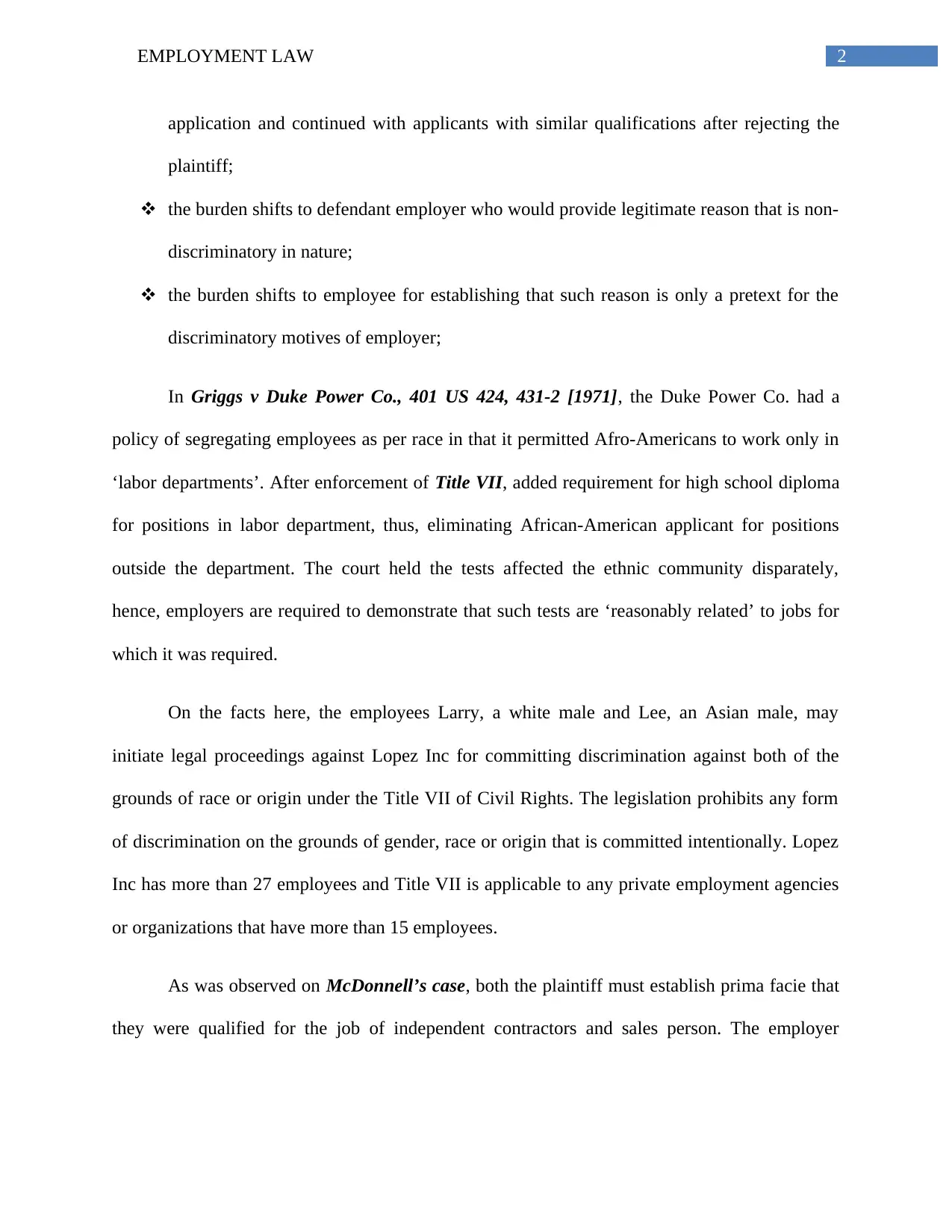
2EMPLOYMENT LAW
application and continued with applicants with similar qualifications after rejecting the
plaintiff;
the burden shifts to defendant employer who would provide legitimate reason that is non-
discriminatory in nature;
the burden shifts to employee for establishing that such reason is only a pretext for the
discriminatory motives of employer;
In Griggs v Duke Power Co., 401 US 424, 431-2 [1971], the Duke Power Co. had a
policy of segregating employees as per race in that it permitted Afro-Americans to work only in
‘labor departments’. After enforcement of Title VII, added requirement for high school diploma
for positions in labor department, thus, eliminating African-American applicant for positions
outside the department. The court held the tests affected the ethnic community disparately,
hence, employers are required to demonstrate that such tests are ‘reasonably related’ to jobs for
which it was required.
On the facts here, the employees Larry, a white male and Lee, an Asian male, may
initiate legal proceedings against Lopez Inc for committing discrimination against both of the
grounds of race or origin under the Title VII of Civil Rights. The legislation prohibits any form
of discrimination on the grounds of gender, race or origin that is committed intentionally. Lopez
Inc has more than 27 employees and Title VII is applicable to any private employment agencies
or organizations that have more than 15 employees.
As was observed on McDonnell’s case, both the plaintiff must establish prima facie that
they were qualified for the job of independent contractors and sales person. The employer
application and continued with applicants with similar qualifications after rejecting the
plaintiff;
the burden shifts to defendant employer who would provide legitimate reason that is non-
discriminatory in nature;
the burden shifts to employee for establishing that such reason is only a pretext for the
discriminatory motives of employer;
In Griggs v Duke Power Co., 401 US 424, 431-2 [1971], the Duke Power Co. had a
policy of segregating employees as per race in that it permitted Afro-Americans to work only in
‘labor departments’. After enforcement of Title VII, added requirement for high school diploma
for positions in labor department, thus, eliminating African-American applicant for positions
outside the department. The court held the tests affected the ethnic community disparately,
hence, employers are required to demonstrate that such tests are ‘reasonably related’ to jobs for
which it was required.
On the facts here, the employees Larry, a white male and Lee, an Asian male, may
initiate legal proceedings against Lopez Inc for committing discrimination against both of the
grounds of race or origin under the Title VII of Civil Rights. The legislation prohibits any form
of discrimination on the grounds of gender, race or origin that is committed intentionally. Lopez
Inc has more than 27 employees and Title VII is applicable to any private employment agencies
or organizations that have more than 15 employees.
As was observed on McDonnell’s case, both the plaintiff must establish prima facie that
they were qualified for the job of independent contractors and sales person. The employer
⊘ This is a preview!⊘
Do you want full access?
Subscribe today to unlock all pages.

Trusted by 1+ million students worldwide
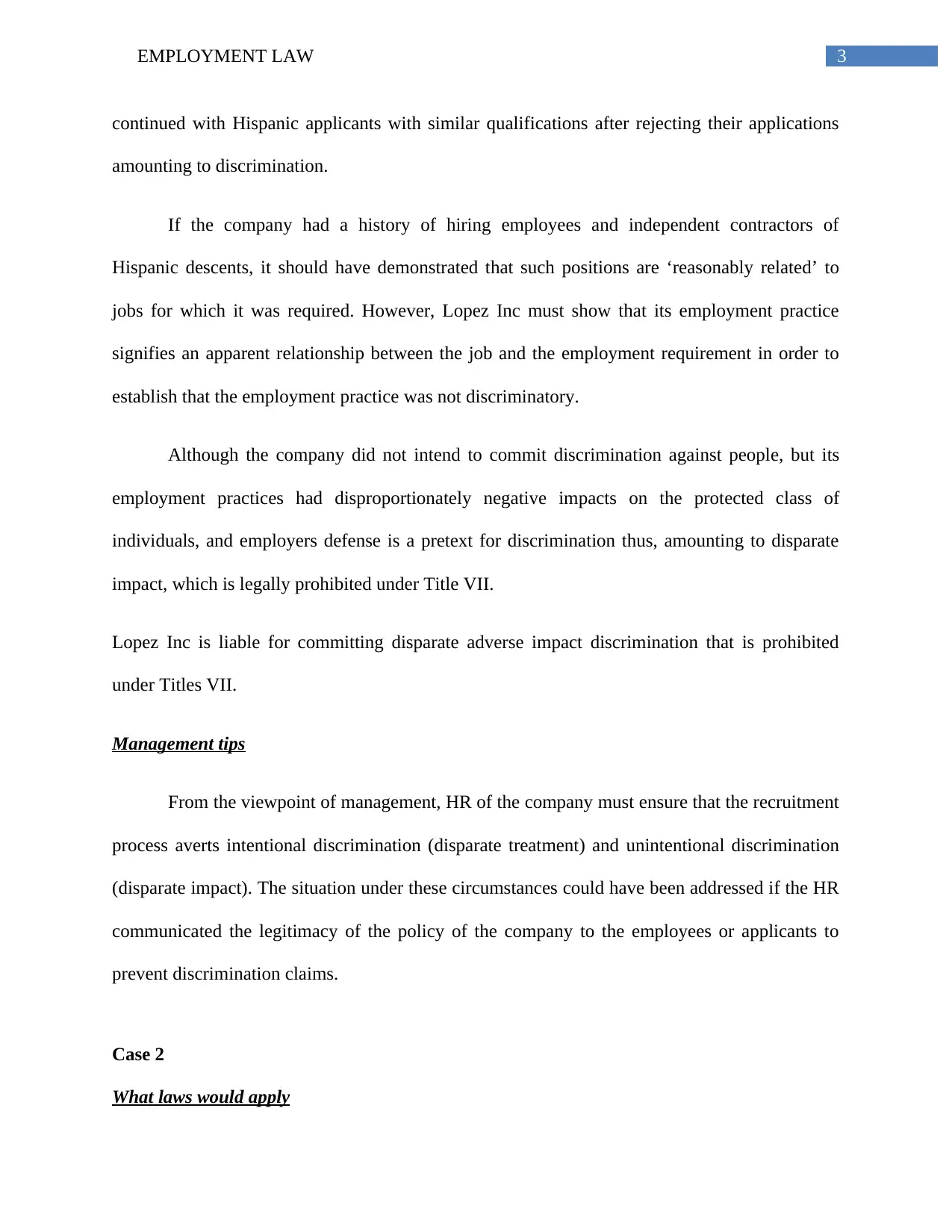
3EMPLOYMENT LAW
continued with Hispanic applicants with similar qualifications after rejecting their applications
amounting to discrimination.
If the company had a history of hiring employees and independent contractors of
Hispanic descents, it should have demonstrated that such positions are ‘reasonably related’ to
jobs for which it was required. However, Lopez Inc must show that its employment practice
signifies an apparent relationship between the job and the employment requirement in order to
establish that the employment practice was not discriminatory.
Although the company did not intend to commit discrimination against people, but its
employment practices had disproportionately negative impacts on the protected class of
individuals, and employers defense is a pretext for discrimination thus, amounting to disparate
impact, which is legally prohibited under Title VII.
Lopez Inc is liable for committing disparate adverse impact discrimination that is prohibited
under Titles VII.
Management tips
From the viewpoint of management, HR of the company must ensure that the recruitment
process averts intentional discrimination (disparate treatment) and unintentional discrimination
(disparate impact). The situation under these circumstances could have been addressed if the HR
communicated the legitimacy of the policy of the company to the employees or applicants to
prevent discrimination claims.
Case 2
What laws would apply
continued with Hispanic applicants with similar qualifications after rejecting their applications
amounting to discrimination.
If the company had a history of hiring employees and independent contractors of
Hispanic descents, it should have demonstrated that such positions are ‘reasonably related’ to
jobs for which it was required. However, Lopez Inc must show that its employment practice
signifies an apparent relationship between the job and the employment requirement in order to
establish that the employment practice was not discriminatory.
Although the company did not intend to commit discrimination against people, but its
employment practices had disproportionately negative impacts on the protected class of
individuals, and employers defense is a pretext for discrimination thus, amounting to disparate
impact, which is legally prohibited under Title VII.
Lopez Inc is liable for committing disparate adverse impact discrimination that is prohibited
under Titles VII.
Management tips
From the viewpoint of management, HR of the company must ensure that the recruitment
process averts intentional discrimination (disparate treatment) and unintentional discrimination
(disparate impact). The situation under these circumstances could have been addressed if the HR
communicated the legitimacy of the policy of the company to the employees or applicants to
prevent discrimination claims.
Case 2
What laws would apply
Paraphrase This Document
Need a fresh take? Get an instant paraphrase of this document with our AI Paraphraser
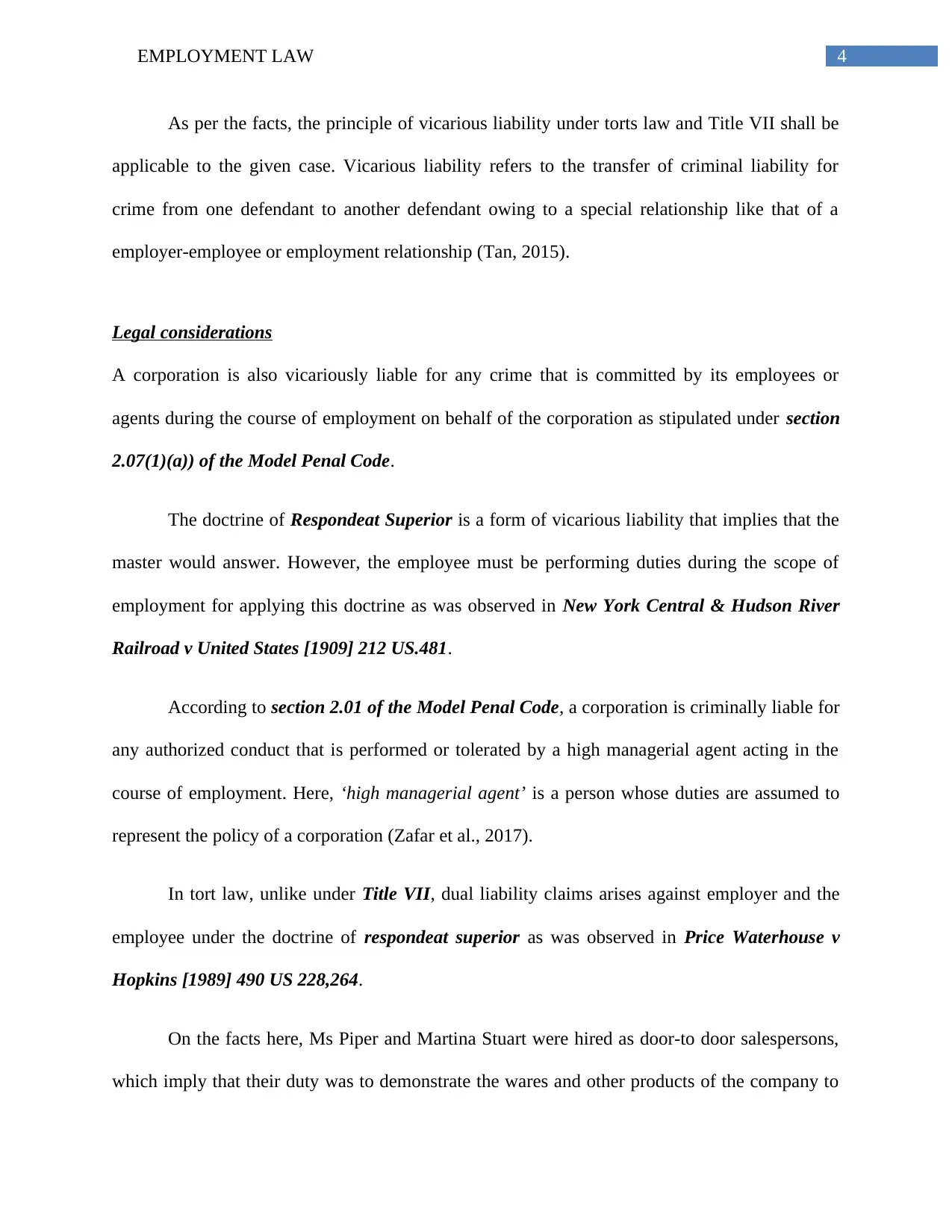
4EMPLOYMENT LAW
As per the facts, the principle of vicarious liability under torts law and Title VII shall be
applicable to the given case. Vicarious liability refers to the transfer of criminal liability for
crime from one defendant to another defendant owing to a special relationship like that of a
employer-employee or employment relationship (Tan, 2015).
Legal considerations
A corporation is also vicariously liable for any crime that is committed by its employees or
agents during the course of employment on behalf of the corporation as stipulated under section
2.07(1)(a)) of the Model Penal Code.
The doctrine of Respondeat Superior is a form of vicarious liability that implies that the
master would answer. However, the employee must be performing duties during the scope of
employment for applying this doctrine as was observed in New York Central & Hudson River
Railroad v United States [1909] 212 US.481.
According to section 2.01 of the Model Penal Code, a corporation is criminally liable for
any authorized conduct that is performed or tolerated by a high managerial agent acting in the
course of employment. Here, ‘high managerial agent’ is a person whose duties are assumed to
represent the policy of a corporation (Zafar et al., 2017).
In tort law, unlike under Title VII, dual liability claims arises against employer and the
employee under the doctrine of respondeat superior as was observed in Price Waterhouse v
Hopkins [1989] 490 US 228,264.
On the facts here, Ms Piper and Martina Stuart were hired as door-to door salespersons,
which imply that their duty was to demonstrate the wares and other products of the company to
As per the facts, the principle of vicarious liability under torts law and Title VII shall be
applicable to the given case. Vicarious liability refers to the transfer of criminal liability for
crime from one defendant to another defendant owing to a special relationship like that of a
employer-employee or employment relationship (Tan, 2015).
Legal considerations
A corporation is also vicariously liable for any crime that is committed by its employees or
agents during the course of employment on behalf of the corporation as stipulated under section
2.07(1)(a)) of the Model Penal Code.
The doctrine of Respondeat Superior is a form of vicarious liability that implies that the
master would answer. However, the employee must be performing duties during the scope of
employment for applying this doctrine as was observed in New York Central & Hudson River
Railroad v United States [1909] 212 US.481.
According to section 2.01 of the Model Penal Code, a corporation is criminally liable for
any authorized conduct that is performed or tolerated by a high managerial agent acting in the
course of employment. Here, ‘high managerial agent’ is a person whose duties are assumed to
represent the policy of a corporation (Zafar et al., 2017).
In tort law, unlike under Title VII, dual liability claims arises against employer and the
employee under the doctrine of respondeat superior as was observed in Price Waterhouse v
Hopkins [1989] 490 US 228,264.
On the facts here, Ms Piper and Martina Stuart were hired as door-to door salespersons,
which imply that their duty was to demonstrate the wares and other products of the company to
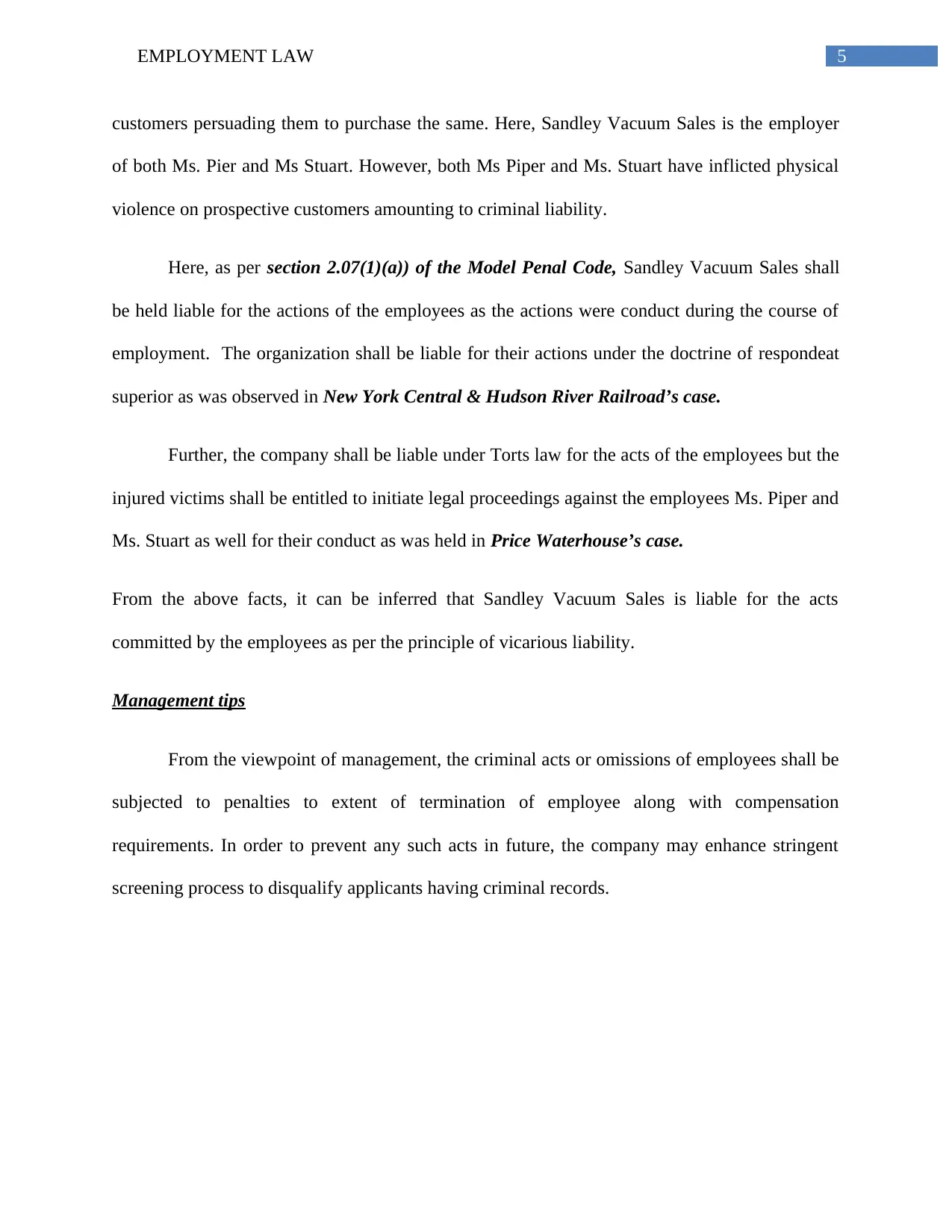
5EMPLOYMENT LAW
customers persuading them to purchase the same. Here, Sandley Vacuum Sales is the employer
of both Ms. Pier and Ms Stuart. However, both Ms Piper and Ms. Stuart have inflicted physical
violence on prospective customers amounting to criminal liability.
Here, as per section 2.07(1)(a)) of the Model Penal Code, Sandley Vacuum Sales shall
be held liable for the actions of the employees as the actions were conduct during the course of
employment. The organization shall be liable for their actions under the doctrine of respondeat
superior as was observed in New York Central & Hudson River Railroad’s case.
Further, the company shall be liable under Torts law for the acts of the employees but the
injured victims shall be entitled to initiate legal proceedings against the employees Ms. Piper and
Ms. Stuart as well for their conduct as was held in Price Waterhouse’s case.
From the above facts, it can be inferred that Sandley Vacuum Sales is liable for the acts
committed by the employees as per the principle of vicarious liability.
Management tips
From the viewpoint of management, the criminal acts or omissions of employees shall be
subjected to penalties to extent of termination of employee along with compensation
requirements. In order to prevent any such acts in future, the company may enhance stringent
screening process to disqualify applicants having criminal records.
customers persuading them to purchase the same. Here, Sandley Vacuum Sales is the employer
of both Ms. Pier and Ms Stuart. However, both Ms Piper and Ms. Stuart have inflicted physical
violence on prospective customers amounting to criminal liability.
Here, as per section 2.07(1)(a)) of the Model Penal Code, Sandley Vacuum Sales shall
be held liable for the actions of the employees as the actions were conduct during the course of
employment. The organization shall be liable for their actions under the doctrine of respondeat
superior as was observed in New York Central & Hudson River Railroad’s case.
Further, the company shall be liable under Torts law for the acts of the employees but the
injured victims shall be entitled to initiate legal proceedings against the employees Ms. Piper and
Ms. Stuart as well for their conduct as was held in Price Waterhouse’s case.
From the above facts, it can be inferred that Sandley Vacuum Sales is liable for the acts
committed by the employees as per the principle of vicarious liability.
Management tips
From the viewpoint of management, the criminal acts or omissions of employees shall be
subjected to penalties to extent of termination of employee along with compensation
requirements. In order to prevent any such acts in future, the company may enhance stringent
screening process to disqualify applicants having criminal records.
⊘ This is a preview!⊘
Do you want full access?
Subscribe today to unlock all pages.

Trusted by 1+ million students worldwide
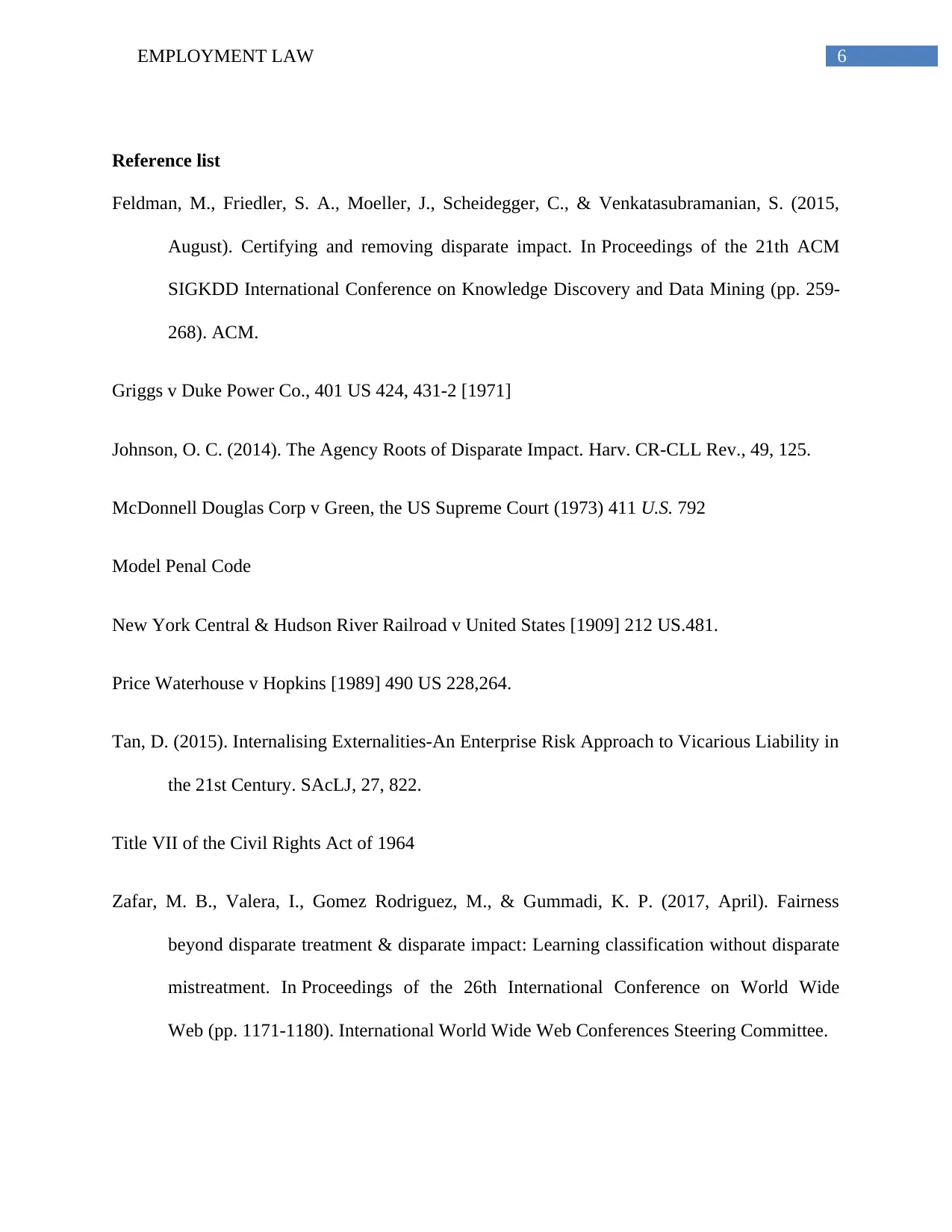
6EMPLOYMENT LAW
Reference list
Feldman, M., Friedler, S. A., Moeller, J., Scheidegger, C., & Venkatasubramanian, S. (2015,
August). Certifying and removing disparate impact. In Proceedings of the 21th ACM
SIGKDD International Conference on Knowledge Discovery and Data Mining (pp. 259-
268). ACM.
Griggs v Duke Power Co., 401 US 424, 431-2 [1971]
Johnson, O. C. (2014). The Agency Roots of Disparate Impact. Harv. CR-CLL Rev., 49, 125.
McDonnell Douglas Corp v Green, the US Supreme Court (1973) 411 U.S. 792
Model Penal Code
New York Central & Hudson River Railroad v United States [1909] 212 US.481.
Price Waterhouse v Hopkins [1989] 490 US 228,264.
Tan, D. (2015). Internalising Externalities-An Enterprise Risk Approach to Vicarious Liability in
the 21st Century. SAcLJ, 27, 822.
Title VII of the Civil Rights Act of 1964
Zafar, M. B., Valera, I., Gomez Rodriguez, M., & Gummadi, K. P. (2017, April). Fairness
beyond disparate treatment & disparate impact: Learning classification without disparate
mistreatment. In Proceedings of the 26th International Conference on World Wide
Web (pp. 1171-1180). International World Wide Web Conferences Steering Committee.
Reference list
Feldman, M., Friedler, S. A., Moeller, J., Scheidegger, C., & Venkatasubramanian, S. (2015,
August). Certifying and removing disparate impact. In Proceedings of the 21th ACM
SIGKDD International Conference on Knowledge Discovery and Data Mining (pp. 259-
268). ACM.
Griggs v Duke Power Co., 401 US 424, 431-2 [1971]
Johnson, O. C. (2014). The Agency Roots of Disparate Impact. Harv. CR-CLL Rev., 49, 125.
McDonnell Douglas Corp v Green, the US Supreme Court (1973) 411 U.S. 792
Model Penal Code
New York Central & Hudson River Railroad v United States [1909] 212 US.481.
Price Waterhouse v Hopkins [1989] 490 US 228,264.
Tan, D. (2015). Internalising Externalities-An Enterprise Risk Approach to Vicarious Liability in
the 21st Century. SAcLJ, 27, 822.
Title VII of the Civil Rights Act of 1964
Zafar, M. B., Valera, I., Gomez Rodriguez, M., & Gummadi, K. P. (2017, April). Fairness
beyond disparate treatment & disparate impact: Learning classification without disparate
mistreatment. In Proceedings of the 26th International Conference on World Wide
Web (pp. 1171-1180). International World Wide Web Conferences Steering Committee.
Paraphrase This Document
Need a fresh take? Get an instant paraphrase of this document with our AI Paraphraser
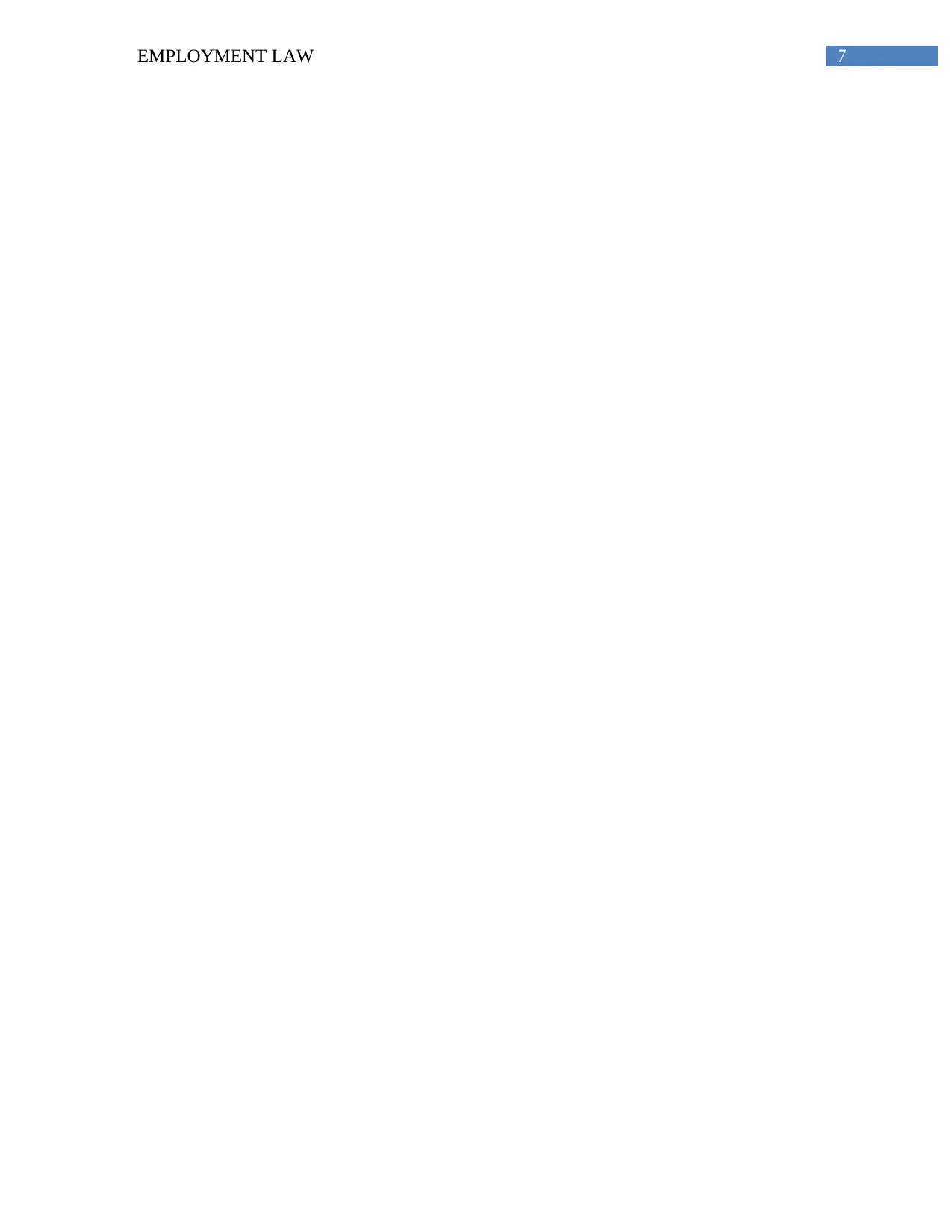
7EMPLOYMENT LAW
1 out of 8
Related Documents
Your All-in-One AI-Powered Toolkit for Academic Success.
+13062052269
info@desklib.com
Available 24*7 on WhatsApp / Email
![[object Object]](/_next/static/media/star-bottom.7253800d.svg)
Unlock your academic potential
Copyright © 2020–2025 A2Z Services. All Rights Reserved. Developed and managed by ZUCOL.





